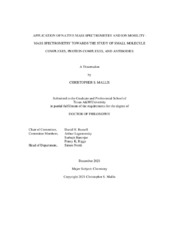| dc.description.abstract | Native mass spectrometry (nMS) is an expanding technique whereby ions with low internal energies are ionized and non-covalent structural elements remain intact following desolvation from solution-phase molecules to solvent-free, gas-phase ions. By retaining weak, non-covalent interactions (i.e. H-bonds, salt bridges, hydrophobic contacts), these ions can be kinetically trapped in their solution conformers for analysis in the gas phase. Hyphenation of nMS with ion mobility (nIM-MS) then provides structural details of conformer preferences by separating ions by their size and/or shape to complement the mass and charge information encoded in the resulting IM-MS spectra.
Principles of nIM-MS are applied to study labile non-biologically relevant small molecules formed through coordination-driven self-assembly (CDSA) reactions of rigid bidentate ligands capped with electron donating pyridyl groups or electron accepting, square planar Pt(II) groups. By retaining low ion internal energies, we show that these reaction products can maintain their solution-phase structures in the gas phase. nMS methods are also applied without IM separation towards the characterization of native large biomolecular complexes (>100 kDa), including soluble protein complexes, membrane protein complexes, and the protein chaperonin GroEL. Under the appropriate solution and instrument conditions, these protein complexes produce well-resolved charge state distributions with high sensitivity to better interrogate large protein contaminants at low relative abundances.
When sampled from native-like buffer conditions (e.g. ammonium acetate), high resolution MS of the monoclonal antibody (mAb), human immunoglobulin gamma-1 kappa (IgG1κ) reveals the expected N-glycan mass profile. In addition to the distribution of glycoforms, at high resolution, we observe signals corresponding to an increase in mass of 40 Da to each glycan peak. The mass shift does not correspond to a common post-translational modification; however, we interrogate the identity of this mass shift as (i) an exchange of mannose (Man) or galactose (Gal) sugar residue with an N-acetylglucosamine (GlcNAc) on the N-glycan structures, (ii) possible metal adduction of endogenous K⁺ or Ca²⁺ cations, or (iii) single point mutations of amino acid residues in the primary sequence of the heavy chain.
Finally, nIM-MS spectra can have utility in discerning shifts in ground-state arrival-time or conformer population distributions; however, for some proteins and protein complexes, the changes in structure may not significantly affect the ground state conformer distributions. Collision-induced unfolding (CIU) works to probe the gas-phase conformational landscape through progressive collisional activation of the flexible ion of interest, (namely proteins and protein complexes) and correlating the collision-cross section (CCS) distribution as a function of collision energy or an instrument collision voltage. CIU experiments have traditionally been performed on travelling-wave IMS (TWIMS) based instrumentation; however, these instruments require external calibrants for CCS determinations and lose considerable sensitivity at the high m/z regimes needed to sample larger native protein complexes. We worked to evaluate a new desolvation assembly design with capabilities for higher energy CIU of large protein complexes in N₂ without the need for additional dopant gases (e.g. Ar, SF₆) in collaboration with a cross laboratory study prior to commercialization of the technology. | |


